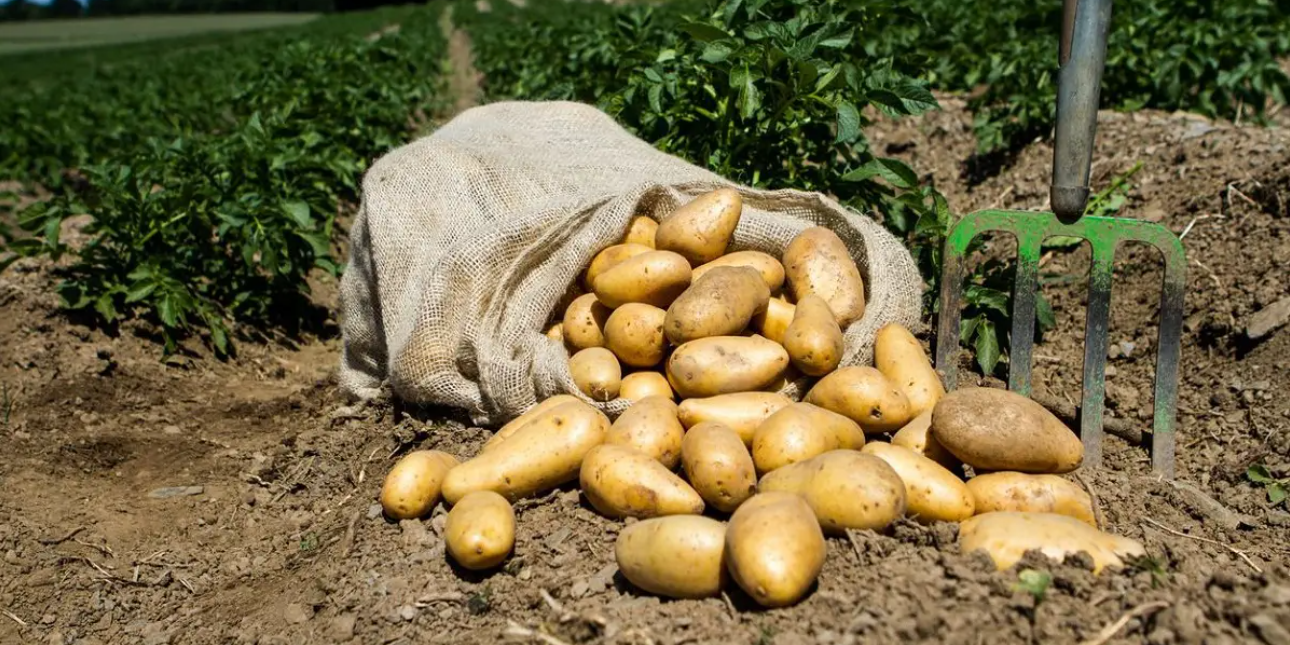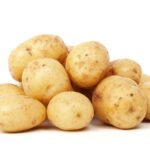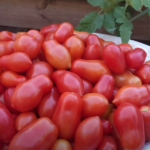Kennebec potatoes are an all-purpose potato variety most suited for culinary applications such as fries, baking, boiling, chipping and frying. The tuber has white flesh and smooth thin skin which ranges from white to a creamy buff color to pale yellow or light tan. Kennebec potatoes are adapted to grow in many parts of the world. They are a high yielding variety. One of the most important features of the Kennebec potato is fortification against light blight potato disease. The variety is an heirloom kind which has been in production for at least 75 years since its release on the American market.
Table of Contents
Potato Kitchen Utensils
A note as we begin. Over and above being one of the most consumed vegetables in North America, potatoes play an important dietary role in a home setting regardless of variety (see nutrition section). The potato is a vegetable that constantly features among home cooking ingredients. Ultimately, the impact of potatoes on human health rests on how they are prepared. The following is our considered list of potato kitchen utensils that assist in producing the best potato cooking and eating experience.
- Potato air fryer
- Potato cooker bag
- French Fry Potato Cutter
- Potato casserole dish
- Potato masher
- Hand potato peeler
- Electric potato peeler
- Potato ricer
- Potato crinkle cutter
- Potato storage canister
- Potato storage bin
- Potato scrubber brush
- Home potato grow bag
What are Kennebec Potatoes?
Kennebec potatoes, like thousands of other classic potato varieties, are a Solanum tuberosum species of the nightshade Solanaceae family. Other common vegetables which are Solanaceae family members include peppers, tomatoes and eggplant. Kennebec potatoes are an heirloom potato variety which has been in cultivation for many decades.
The Kennebec was developed and released in 1948 by the USDA and Maine Agricultural Experiment Station in the United States. Although considered White potatoes, Kennebec potatoes have varying particulars compared to other known white potato varieties. This could be a result of the crossing that took place during breeding many years following the 19th century arrival of the original Irish White Potato in the United States.
For instance, as much as Kennebec potatoes have smooth thin skin, their skin color ranges from white to dark brown in some cases. However, typical of White potatoes, the Kennebec has white flesh and medium starch content which supports some of its good culinary qualities that makes it ideal for use in curries, soups and stews, for example.
Kennebec Potato Characteristics
Although Kennebec potatoes have been popular, they have some inherent weaknesses which later potato varieties have attempted to address. One of the main weaknesses is difficult storage (see storage section). The variety is also prone to Verticillium wilt, a fungal disease which can reduce tuber size. Kennebec also has a tendency to develop Knobby or deformed potato tubers under higher growing temperatures. Clearly, although a highly regarded and good potato, these are some significant limitations that accompany the potato.
Home gardeners will, however, need to keep in mind that according to one source, “Kennebec will vary in quality according to the environment in which it is grown and the cultural practices of the growers”. One of the reasons the potato remains among top potatoes grown in Maine, the United States, is that the variety grows very well in that environment and produces potatoes of excellent cooking quality.
The following is a summary of Kennebec potato characteristics.
| Botanical name – Solanum tuberosum |
| Scientific family – Solanaceae, Nightshade |
| Group – Vegetable, carbohydrate group |
| Origins – United States (1948) |
| Shape – Oblong, somewhat flattened, shallow eyes |
| Tuber size – Medium size to large |
| Skin – Smooth, thin, white to pale-yellow, light tan |
| Flesh – White flesh |
| Starch level – Medium, lower than Russet |
| Flavor – Nutty, earthy flavor |
| Uses – Fries, soups, stews, roasting, boiling, steaming, mashing, chips |
| Planting – Cool-season |
| Soils – Well draining, acidic, slightly acidic |
| Conditions – Full sun |
| Harvest – 90 to 120 days |
| Diseases – Verticillium wilt, common scab |
| Weaknesses – Poor storage |
Kennebec Potatoes vs Russet Potatoes
A comparison between Kennebec potatoes and Russet potatoes reveals more differences than similarities. Juxtaposed, these are distinctly two different potato cultivars. As earlier mentioned, Kennebec is a White potato variety released in 1948 while Russet potato is a much older potato cultivar developed in the 1870s as the Russet Burbank potato. Out of this original cultivar ancestry have come numerous Russet potato varieties.
In culinary terms, Russet potato is a baking potato while Kennebec is a frying potato. Russet potato has been called the King of baking potatoes. Second to baking, Russet can also be used and shine when making French fries and mashed potatoes. While the Kennebec is considered an all-purpose potato, Russet lands in the starchy category. It has a higher starch content than Kennebec potatoes.
Other particular differences are that while Kennebec potatoes have a thin, smooth and light skin, Russet potatoes typically have thick, rough, dark brown skin with very dry flesh. The high starch content and dry flesh contribute to Russet’s suitability as a glowing baking potato.
Despite the marked contrast between the two potato cultivars, pertaining size and shape, the two potato types share some similarities. Both produce generally large tubers. The Russet potato typically has a cylindrical, long and large tuber. The Kennebec potato is a well known large, oblong looking tuber.
We have already mentioned the weakness in storage of the Kennebec potato. Compared to Kennebec potatoes, Russet potatoes have a reputation of storing well for long periods with sugars remaining low. Furthermore, Russet is also resistant to scab disease, an unsightly bacterium caused potato malady which results in crust looking raised patches on the surface of the potatoes.
Notwithstanding the differences highlighted, Kennebec and Russet potatoes can successfully be used interchangeably in some home recipe preparations. We have in mind here, potato salads.
Kennebec Potato Nutrition
As an Irish White potato, Kennebec potato nutrition conforms to what is already known about White potato nutrition. According to Medical News Today a 100 grams or 3.5 ounce of baked White potato with the skin on delivers only 95 calories. In addition, this same quantity of potato is high in potassium at 544 mg and 12.6 mg of vitamin C.
The favorable nutritional profile of Kennebec White potatoes is supported by the study, White Potatoes, Human Health, and Dietary Guidance, as published in 2013 in the international journal Advances in Nutrition. According to the journal, White potatoes are a concentrated source of vitamin C and potassium. Furthermore, the journal states that this potato type is “a concentrated source of carbohydrate, dietary fiber, and resistant starch.” Resistant starch is a starch that does not digest easily which is useful in reducing calorie intake. This type of starch is beneficial to the large intestines where it ferments and promotes favorable gut bacteria.
All things considered, the worry with potatoes and that have earned them a bad rap in recent years has had to do with how they are prepared. Deep frying potatoes, adding butter and oils all build on the calories which increases the risk of obesity and related health problems. As White potatoes, Kennebec potatoes have been shown scientifically to provide important nutrients alongside other white vegetables such as white eggplants and white onions.
Kennebec Potato Seeds
Potato seeds come in the form of live tubers which are usually small seed potatoes especially produced for planting. They can also be cuttings of full grown potatoes with eyes.
Kennebec potatoes are among home gardeners’ favorite potato varieties to grow. Their high yield, resistance to the devastating light blight disease, iconic reputation and scrumptious culinary applications are among some of the attractive features of this variety that compels home growers to raise them.
As far as seed production is concerned, Kennebec potato is not protected by the U.S Plant Variety Protection Act (PVPA), a form of patent (example) which gives variety developers 25 years of “exclusive control over new, distinct, uniform, and stable sexually reproduced or tuber propagated plant varieties”. As earlier stated, Kennebec potatoes, which are tuber propagated, were released some 75 years ago.
Due to the potato’s PVPA status, seed for this variety is widely accessible. The following are some Kennebec seed suppliers in North America.
- Kennebec Potato Seeds via Amazon
- Urban Farmer Kennebec Seed Potatoes
- Johnny’s Seeds Kennebec Seed Potatoes
- Hoss Kennebec White Potato Seeds
- Pinetree Garden Seeds Kennebec Potatoes
- Harris Seeds Kennebec Potato Seeds
- TT Seeds Kennebec Seed Potatoes
Kennebec Potato Recipes
Kennebec Fries
As earlier stated, Kennebec potato uses include certain culinary recipe applications with frying being at the forefront. Kennebec has been so renowned for best fries to the extent that some restaurants in the United States list fries on their menus as “Kennebec Fries”. Although widely available to grow for anyone who so wishes, restaurant entrepreneurs have successfully made Kennebec made fries unique and exotic to a degree for commercial advantage.
Nevertheless, many online French Fries recipes tend to use Russet potatoes. Notwithstanding, the Kennebec spud is known to produce superior firm crispy fries that brown well due to the lower water content. Regardless of the poor storing, the well praised frying ability of the Kennebec potato still made it attractive with restaurants. Well known U.S restaurants that carry Kennebec Fries by name on the menu include Sand Point Grill.
Kennebec Potato Substitute
If you wanted an alternative frying potato, Russet potatoes would work as a substitute to Kennebec. Although shining more as a baking potato, Russet will also do well frying. This means it is a suitable substitute for producing French fries and other fried potato products. This also explains why many online recipes for fries tend to use Russet.
Furthermore, Russet potatoes can also substitute Kennebec in making potato salads perhaps not so much for stews especially stews with high liquid portions as the high starch level in Russet could produce a gluey unattractive texture in the stew. Yukon Gold potatoes play a better substitutive role for the Kennebec when making stews due to their medium starch content. For this reason, many stew recipes that do not use White potatoes turn to Yukon Gold often.
Overall, being an all-purpose potato with medium-starch content, many potato varieties with medium to low starch content will likely do well in replacing Kennebec potatoes in recipes. The best place to start are other White potato varieties as they have a similar profile to the Kennebec, itself a White potato.
On the home kitchen front, Kennebec is still a frying potato but is also applicable in some delicious recipes that exemplify other recipe uses not only limited to frying. The following are some recipes to try out using this potato.
Crispy Hasselback Potatoes Recipe
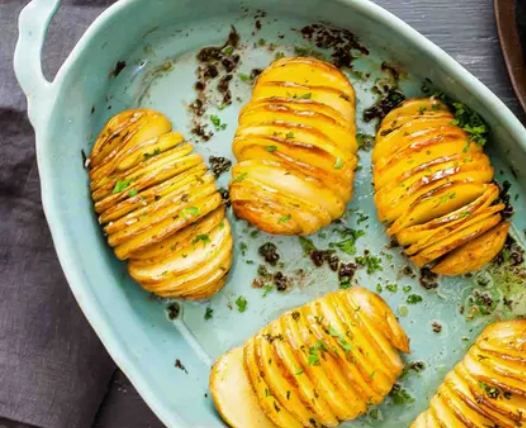
Most potatoes will do well in a hasselback recipe. For this hasselback recipe, Kennebec potatoes can be used with a great outcome. Yukon Gold potato can also be used here as a substitute to Kennebec. This recipe takes 90 minutes to make with 70 minutes of it being cook time.
This is an easy recipe to make with a scrumptious outcome and does not call for too many ingredients. Apart from the potatoes other ingredients required are unsalted butter, olive oil, fresh parsley and salt to taste. View Recipe.
Oven Fries Recipe
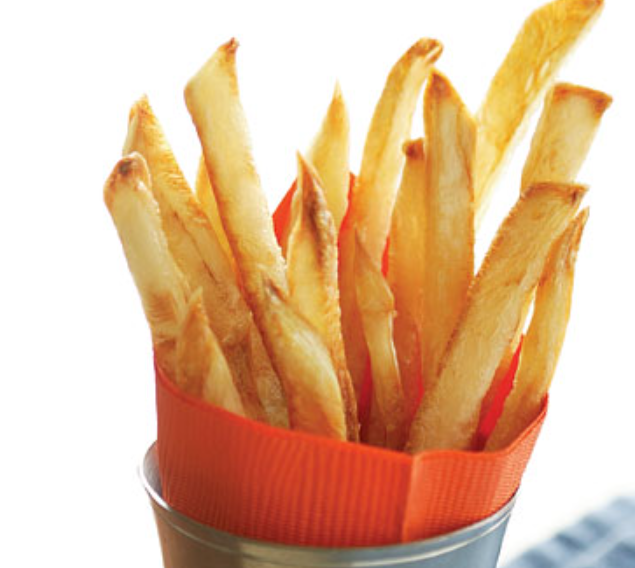
This recipe, as is common with many online recipes, uses Russet potatoes to make some delicious oven fries. The potatoes are first rinsed in clear water to remove some of the starch. As we have been showing in this article, Russet potatoes have higher starch content than Kennebec White potatoes.
The Russet potatoes in this recipe can thus be substituted with Kennebecs, as we have also shown, which restaurants rely upon for delicious looking fries. Use a French Fry Potato Cutter (example) to produce aesthetically inviting potato sticks. Apart from the potatoes themselves, the only other ingredients for this recipe are extra virgin olive oil and salt. The potatoes will roast for about 30 minutes in the oven. View Recipe.
Cauliflower Mashed Kennebec Potatoes Recipe
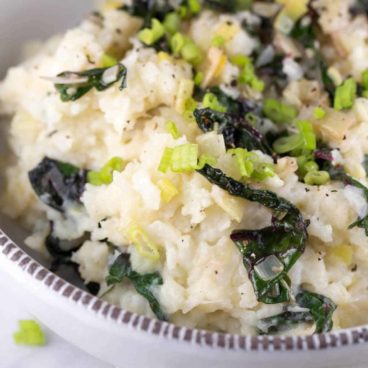
This recipe produces a delicious tasting dish of mashed potatoes with cauliflower. The recipe calls for Yukon Gold potatoes or White potatoes. Kennebec potatoes will come in as the White potatoes stated in this recipe. Other recipe ingredients will be olive oil, garlic, leek, swiss chard and unsalted butter among others.
The potatoes and cauliflower are added to water that has been boiled and let to sit for some 15 minutes to make them tender. The vegetables are then lightly mashed after they become tender and the water is drained. This recipe takes 35 minutes to make and serves 4. View Recipe.
Garlic, Broccoli and Potato Foil Recipe
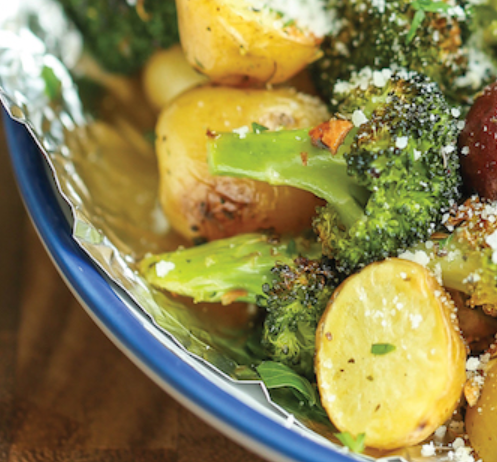
The forgoing recipes have been calling for fully mature Kennebec potatoes. This recipe breaks away from this pattern by calling for baby potatoes. You can use Kennebec baby potatoes in this recipe. Baby potatoes are also known as new potatoes, small-sized potatoes or mini potatoes. Other notable recipe ingredients are garlic and broccoli.
On the broccoli, for color and nutrition there is also an opportunity to use purple broccoli by itself or mixed with regular green broccoli. Parmesan cheese, fresh parsley, olive oil and Italian seasoning (example) will be some of the other ingredients going into the recipe. This recipe takes 25 minutes to make and produces 4 servings. View Recipe.
Growing Kennebec Potatoes
Growing Kennebec conforms to the fundamentals involved in rising potatoes in general. Potatoes are cool-season crops that flourish in fertile, well-drained, sandy loam soils with a pH of between 5.5 and 6.8. As earlier stated, how the Kennebec potato performs will be down to environmental factors. For example, in Maine where it is among the top grown potatoes, it is a fast growing, high yielding potato producing large tubers.
Nonetheless, in general terms Kennebec is a dependable potato variety under wide ranging growing conditions. Tests done in other parts of the world before its 1948 release showed that it is an adaptable potato variety to different growing conditions. Concerning pests and diseases, although resistant to late blight disease, Kennebec potatoes are susceptible to scab and early blight infection.
There is more to appreciate about growing potatoes. For in depth knowledge about best practices when growing potatoes, we recommend this Potato Production guide by Oklahoma State University Extension.
Kennebec Potato Storage
Once harvested the next consideration when handling potatoes is storage. Different potato varieties store differently. As earlier mentioned, Kennebec has weaknesses in storage. The potato is easily perishable which is one of the reasons it had been less attractive to restaurants as also highlighted in this report.
In particular, Kennebec potatoes are susceptible to Pink Eye, a potato disorder that occurs whilst potatoes are in storage, damaging tuber quality and attractiveness. Furthermore, Kennebec has a tendency to bruise easily in and out of storage.
University of Nebraska-Lincoln identifies 5 types of potato bruising which are cuts/slices, skinning, shatter, pressure and blackspot. Pressure bruising primarily occurs in storage whilst shatter bruising and blackspot are associated with harvest. Maturity, temperature and hydration of the tubers contributes to the severity of the bruising.
As earlier stated, one of the parents of the Kennebec potato is the Katahdin variety. A study published in the American Potato Journal discovered that as much as 20% of Katahdin potato tubers sampled were bruised during the harvesting process so much as to be a potential market loss. It is apparent that Kennebec inherited some of these storage problem traits from its parents.
Nevertheless, preventing potato bruising is a wholesome approach which begins with plant nutrition itself whilst the tubers are still in the ground. Low potassium, calcium and boron contribute to bruising. Harvesting is yet another stage in the life of the Kennebec potato that it remains vulnerable to bruising. The potato must not be dropped or knocked by equipment whilst harvesting. Environmental temperatures and soil moisture at harvest are also contributing factors i.e. soils must not be dry at harvest.
The Potato Association of America (PAA) recommends store temperatures of Kennebec potatoes of 50°F or 10°C or above for good chip color. Tablestock Kennebec potatoes can be kept at temperatures of between 36°F to 40°F or 2°C to 4.5°C.
Store Kennebecs in well ventilated spaces. This encourages wound healing and also prevents condensation which causes diseases. Relative humidity in storage spaces should hover at about 95% to minimize weight loss of the tubers. For home potatoes, try storing Kennebec potatoes in purposefully designed potato storage bins (example) or potato storage canisters (example).
Conclusion
Kennebec potatoes have a reputation as excelling at frying potatoes. They are applicable in a variety of frying recipes including French Fries where they have carved out a name among restaurants. Beyond frying, Kennebecs are a White potato with medium-starch content and therefore well suited for making stews, soups and salads.
Being a White potato, this potato variety provides scientifically demonstrated high quality nutritional value. The Kennebec potato is popular with home growers and is also adaptable to cultivation in a variety of environments. Despite its strengths such as certain disease resistance, the potato has weaknesses related to storage which has made it less attractive in some circles.
Recommended Good Reads:
- Purple Lettuce Information
- Frisée Lettuce Information
- Cinnamon Basil Information
- Purple Broccoli Information
- Pimento Peppers Information
- Buttercrunch Lettuce Information
- Boston Lettuce Information
- When to Pick Tomatoes
- Yellow Pear Tomato Information
- Parris Island Cos Romaine Lettuce
- Murasaki Sweet Potatoes Information
- Sweet Potato Recipes
